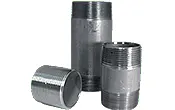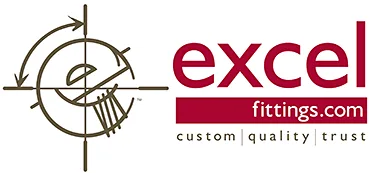Stainless Steel Nipples
Applications
- Seamless For Unrestricted Flow
- Use With Air, Water, Oil, Natural Gas, Steam
- Fittings: Use Threaded Class 3000 High-pressure Stainless Steel.
Standards
- ASTM A733
- ASTM A312
- ANSI/ ASME B1.20.1
- PSI 3000.Stainless steel pipe nipples are manufactured from stainless steel pipe that conforms to specification
- ASTM A312/ SA312.
- All stainless steel nipples conform to specification
- ASTM A733. Threads conform to the requirements of ANSI B1.20.1.

304 Stainless
The basic alloy. Type 304 (18-8) is an austenitic steel possessing a minimum of 18% chromium and 8% nickel, combined with a maximum of 0.08% carbon. It is a nonmagnetic steel which cannot be hardened by heat treatment, but instead. must be cold worked to obtain higher tensile strengths.
Because of its ability to withstand the corrosive action of various acids found in fruits, meats, milk, and vegetables, Type 304 is especially suited for all types of dairy equipment piping and valves, the brewing industry, the citrus and fruit juice industry, and in food processing applications. Also used for the dye tanks, pipelines buckets, dippers, etc. that come in contact with the acetic, and other organic acids used in the dyeing industry.
In the marine environment, because of its slightly higher strength and wear resistance than type 316 it is also used for nuts, bolts, screws, and other fasteners. It is also used for springs, cogs, and other components where both wear and corrosion resistance is needed.
316 Stainless
For severe environments. Of course, there are many industrial processes that require a higher level of resistance to corrosion than Type 304 can offer. For these applications, Type 316 is the answer.
In type 316, the nickel content is increased slightly. What distinguishes Type 316 from Type 304 is the addition of molybdenum up to a maximum of 3%.
Molybdenum increases the corrosion resistance of this chromium-nickel alloy to withstand attack by many industrial chemicals and solvents, and, in particular, inhibits pitting caused by chlorides. As such, molybdenum is one of the single most useful alloying additives in the fight against corrosion.
Type 316 can withstand corrosive attack by sodium and calcium brines, hypochlorite solutions, phosphoric acid; and the sulfite liquors and sulfurous acids used in the paper pulp industry. This alloy, therefore, is specified for industrial equipment that handles the corrosive process chemicals used to produce inks, rayons, photographic chemicals, paper, textiles, bleaches, and rubber. Type 316 is also used extensively for surgical implants within the hostile environment of the body.
The main stainless used in the marine environment, with exception of fasteners and other items where strengths and wear resistance are needed, then Type 304 (18-8) is typically used.
